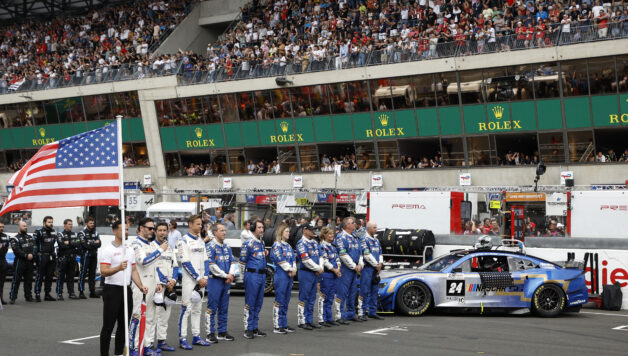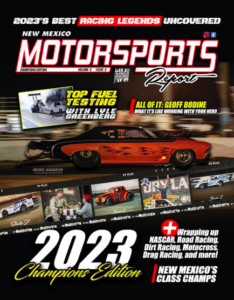NASCAR’s return to Le Mans after nearly five decades was daring, but it paid off
Editor’s note: This column can also be found in the July 2023 edition of the New Mexico Motorsports Report magazine.
It took nearly five decades, but NASCAR made its return to Le Mans in June 2023 with hopes of redemption from its previous endeavor and impressing the automotive world on an international stage.
When the series first appeared at Circuit de la Sarthe in 1976, it brought two cars to compete in the grand sports car race. Hershel McGriff, a winner of four NASCAR Cup Series races, brought himself, his son Doug, and a Dodge Charger and qualified 47th for the 44th running of the 24 Hours of Le Mans. Junie Donlavey, the late NASCAR team owner whose career spanned nearly six decades, also brought a stock car entry — a Ford Torino that was run by Dick Brooks, Dick Hutcherson, and Marcel Mignot.
NASCAR’s debut at the famous French race was anything but spectacular. McGriff’s car had engine issues throughout the trip. When the race finally started, McGriff’s No. 4 completed two laps before a piston failure put an end to the effort. The Charger finished 55th out of 56 cars.
Meanwhile, Donlavey’s No. 90 Torino suffered gearbox issues shortly before the halfway mark of the race. The car qualified 55th and finished 40th after completing 104 laps; thus, NASCAR’s Le Mans experience was over. It was an underwhelming display — one that McGriff said made him “really disappointed in our performance,” in a Motortrend article from September 2020.
Forty-seven years later, a stock car once again ran at the world’s most prestigious endurance race, but the circumstances were different than they were in 1976.
NASCAR and Hendrick Motorsports joined efforts to build a highly modified stock car for Le Mans’ 100th-anniversary event. The vehicle wasn’t competing in any classes as it was a Garage 56 entry, which is a provisional spot on the grid dedicated to showcasing technology and innovation.
The car was based on NASCAR’s Next-Gen car, which is in its second season of use in the Cup Series, and donned the Hendrick No. 24 as made famous by four-time Cup champion Jeff Gordon. But this specially built vehicle features side view mirrors, functioning headlights, and a variety of aerodynamic facets, including a modified splitter and rear diffuser to help create more downforce.
The car was also lighter and had more power than the traditional Next-Gen stock car. It would set quicker lap times compared to a regular Cup Series vehicle.
Jimmie Johnson, who won seven Cup championships with Hendrick, Jensen Button, the 2009 Formula 1 world champion, and Mike Rockenfeller, the renowned sports car driver with two Le Mans wins, drove the Garage 56 Chevrolet Camaro.
The goal for the Garage 56 NASCAR project was to complete the race and not turn into another disappointment.
Team owner Rick Hendrick was excited about the race but worried about the car failing to meet expectations. He didn’t want to see his and NASCAR’s squad “fall on our nose.”
“From the very beginning with Chad (Knaus) and Greg (Ives), I said we’ve got to do this right,” he said. “We don’t spare any expense. Our NASCAR teams can do any kind of race they want to do. I mean, they got the talent, they’ve got the engineers, and they got a lot of smart people, and they can do whatever.”
The car itself piqued the interest of the entire Le Mans paddock. Team members from up and down the grid checked out the car and took photos before the race, as many had probably never seen a NASCAR car in person before.
No points were on the line, and no trophies were there for the taking, but it was a triumph for NASCAR and Hendrick as they completed the race. The car had one minor drive line issue in the final quarter of the 24-hour race, but repairs were made, and it was smooth sailing to the finish. After the checkered flag, the drivers received cheers and applause from fans in the paddock. As Johnson took the flag, NASCAR CEO Jim France raised his hat to salute the car and the driver, who drove the final stint.
The car finished 39th out of 62 entries. And if it hadn’t suffered the mechanical issue, it may have been placed in the 20s, which is where it was running for the majority of the race. It was ahead of many GT vehicles and qualified more than three seconds faster than the quickest LMGTE AM car.
“Thousands of hours of hard work by hundreds of people that went into making this thing happen,” France said. “And then the way the team and the pit crews and everybody performed all week, it was just fantastic.”
NASCAR took a risk in making a return to Le Mans. If it had another showing as it did in 1976, it would not have been a good look for the American series. NASCAR’s reputation for big, seemingly industrial, loud machines built by a bunch of beer-guzzling American mechanics is the stereotype that perhaps some European motorsport fans still believe in today.
Looking at a tall, bulky stock car in the middle of a field of fancy and intricate prototypes created by manufacturers such as Ferrari, Porsche, and Aston Martin, among others, certainly provided a unique appearance to the field. But the motorsports landscape took notice of the big, mean, American machine, and without doubt, NASCAR gained respect from those across the pond.
“I hope my dad and my brother are somewhere up there looking down and smiling, but the goal when we set out was to try and finish the race running at the end and not be last,” France said. “And we accomplished that.”
Photo Credit: LE MANS, FRANCE – JUNE 10: Drivers Jimmie Johnson, Mike Rockenfeller and Jenson Button of the #24 NASCAR Next Gen Chevrolet ZL1 prepare to drive during the 100th anniversary of the 24 Hours of Le Mans at the Circuit de la Sarthe June 10, 2023 in Le Mans, France. (Photo by Chris Graythen/Getty Images)





Social